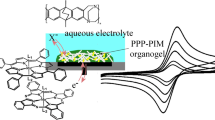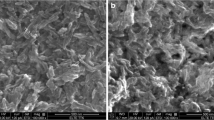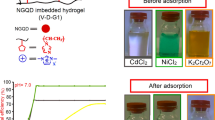Abstract
The retention, release, and detection of metallic complexes in polymeric hydrogels are of interest in drug delivery, analytical chemistry, and water remediation. The electrochemistry of the redox complexes inside the hydrogel could be affected by the viscoelastic properties of the gel, local ionic force and pH, and interactions (e.g., hydrophobic) between the complex and the polymer chains. In this work, it is shown that a simple setup, consisting of a disk electrode pressed on the hydrogel, allows to perform electrochemistry of a redox couple: Tris(1,10-phenanthroline)iron(II) (Fe(phen)3 2+) inside a hydrogel matrix. The behavior is compared with the same couple in solution, and it is found that the electrochemical properties of the redox couple are strongly affected by the presence of the hydrogel matrix. The cyclic voltammogram of the hydrogel loaded with complex shows a response, which suggests electrochemical-chemical mechanism. The chemical step is likely linked to a catalytic oxidation of free hydrated Fe2+ ions present inside the hydrogel together with the redox complex. Since Fe2+ ions have small charge transfer constants on the glassy carbon electrodes, only the catalytic current is observed. Indeed, when excess ligand (phenanthroline) is absorbed inside the hydrogel, the measured cyclic voltammograms show a single reversible oxidation/reduction step. It seems that the complexation equilibrium shifts toward the complex, making the free iron concentration negligible. Accordingly, the cyclic voltammetry shape and peak potential difference agree with a reversible oxidation/reduction. Additionally, the peak currents of the cyclic voltammograms show a linear dependence with the square root of time, as predicted by a Randles-Sevcik equation. However, the measured currents are smaller than the simulated ones. The differences are in agreement with simulations of the cyclic voltammograms where the migration of the redox species is considered. Chronoamperometry is used to measure the mass transport of redox species inside the hydrogel. It is found that the current transients still obey Cottrell’s equation, but the diffusion coefficients obtained from the slopes of Cottrell’s plots have to be corrected for migration effects. The effective diffusion coefficient of Fe(phen)3 2+ measured inside the hydrogel (D Red-hydrogel = 5.5 (±0.5) × 10−8 cm2 s−1) is ca. 80 times smaller than the one measured in solution (D Red-solution = 4.4 (±0.5) × 10−6 cm2 s−1). The simple setup has a true semi-infinite boundary condition, which allows characterizing the hydrogel in the same condition as the bulk material and easily changing both the redox species and the hydrogel structure.







Similar content being viewed by others
References
Kalia S (2016) Polymeric hydrogels as smart biomaterials. Springer, Berlin
Loh JX, Scherman OA (2013) Polymeric and self assembled hydrogels, from fundamental understanding to applications. The Royal Society of Chemistry, Cambridge
Dunn MJ (ed) (1986) Gel electrophoresis of proteins. IOP, Bristol
Molina M, Rivarola C, Barbero C (2012) Study on partition and release of molecules in superabsorbent thermosensitive nanocomposites. Polymer 53:445–453
Simpson NJK (2000) Solid-phase extraction, principles, techniques, and applications. Marcel Dekker, Basel
Bagel O, Degrand C, Limoges B (1999) Ion-exchange voltammetry as a solid-phase Microextraction analytical method: factors influencing the mass transfer to Perfluorosulfonated ionomer film-coated electrodes and some of their consequences on the current responses. Anal Chem 71:3192–3199
Aguilar M, Cortina JL (eds) (2008) Solvent extraction and liquid membranes: fundamentals and applications in new materials. CRC Press, Boca Raton
Lyons M (ed) (1996) Electroactive polymer electrochemistry part 2: methods and applications. Springer, Berlin
Grumelli DE, Wolosiuk A, Forzani E, Planes G, Barbero C, Calvo EJ (2003) Probe beam deflection study of ion exchange in self-assembled redox polyelectrolyte thin films. Chem Commun 3014–3015
Andrieux CP, Haas O, Saveant JM (1986) Catalysis of electrochemical reactions at redox-polymer-coated electrodes. Mediation of the iron(III)/iron(II) oxido-reduction by a polyvinylpyridine polymer containing coordinatively attached bisbipyridine chlororuthenium redox centers. J Am Chem Soc 108:8175–8182
Ju H, Leech D (1997) Electrochemistry of poly(vinylferrocene) formed by direct electrochemical reduction at a glassy carbon electrode. J Chem Soc Faraday Trans 93:1371–1375
Inzelt G, Szabo L (1986) The effect of the nature and the concentration of counter ions on the electrochemistry of poly(vinylferrocene) polymer film electrodes. Electrochim Acta 31:381–1387
Forster RJ, Vos JG, Lyons MEG (1991) Controlling processes in the rate of charge transport through [Os(bipy)2(PVP)nCl]Cl redox polymer-modified electrodes. J Chem Soc Faraday Trans 87:3761–3767
Nyasulu FWM, Mottola HA (1988) Electrochemical behavior of 5-amino-1,10-phenanthroline and oxidative electropolymerization of tris[5-amino-1,10-phenanthroline]iron(II). J Electroanal Chem Interfacial Electrochem 239:175–186
Bachas LG, Cullen L, Hutchins RS, Scott DL (1997) Synthesis, characterization and electrochemical polymerization of eight transition-metal complexes of 5-amino-l,10-phenanthroline. J Chem Soc Dalton Trans 9:1571–1577
Barbero C, Miras MC, Calvo EJ, Kötz R, Haas O (2002) A probe beam deflection study of ion exchange at poly(vinylferrocene) films in aqueous and nonaqueous electrolytes. Langmuir 18:2756–2764
Rubinstein I (1986) Structural effects on the electrochemistry of ferrocene in Nafion films on electrodes. J Electroanal Chem 200:405–410
Buttry DA, Anson FC (1983) Effects of electron exchange and single-file diffusion on charge propagation in Nafion films containing redox couples. J Am Chem Soc 105:685–689
Buriez O, Moretto LM, Ugo P (2006) Ion-exchange voltammetry of tris(2,2isbipyridine) nickel(II), cobalt(II), and Co(salen) at polyestersulfonated ionomer coated electrodes in acetonitrile: reactivity of the electrogenerated low-valent complexes. Electrochim Acta 52:958–964
Silambarasan K, Kumar AVN, Joseph J (2016) K4[Fe(CN)6] immobilized anion sensitive protonated amine functionalized polysilsesquioxane films for ultra-low electrochemical detection of dsDNA. Phys Chem Chem Phys 18:7468–7474
Oh SM, Faulkner LR (1989) Electron transport dynamics in partially quaternized poly(4-vinylpyridine) thin films containing ferri/ferrocyanide. J Electroanal Chem 269:77–97
AA S, Belcher R, Freiser H (1969) Analytical applications of 1,10-phenanthroline and related compounds volume 32. International Series of Monographs on Analytical Chemistry Elsevier, Amsterdam
Luque de Castro MD, Valcarcel M, Albahadyl FN, Mottola HA (1987) Electrochemical behaviour of iron-1,10-phenanthroline complexes at a carbon paste electrode. J. Electroanal Chem 219:139–151
Ogura K, Miyamoto K (1978) Electrode reaction of tris(1-10-phenanthroline)iron(I) complex in aqueous and nonaqueous solvents. Electrochim Acta 23:509–512
Carter MT, Rodriguez M, Bard AJ (1989) Voltammetric studies of the interaction of metal chelates with DNA. 2. Tris-chelated complexes of cobalt(III) and iron(II) with 1,10-phenanthroline and 2,2′-bipyridine. J Am Chem Soc 111:8901–8911
Vallejos S, Munoz A, Ibeas S, Serna F, Garcia FC, Garcia JM (2013) Solid sensory polymer substrates for the quantification of iron in blood, wine and water by a scalable RGB technique. J Mater Chem A 1:15435–15441
http://lem.ch.unito.it/chemistry/esp_manual.html (accessed 1/02/2016).
Bard AJ, Faulkner LR (1980) Electrochemical methods: fundamentals and applications. Wiley, New York
Myland JC, Oldham KB (1999) Limiting currents in potentiostatic voltammetry without supporting electrolyte. Electrochem Commun 1:467–471
Bieniasz LK (2002) Analytical formulae for chronoamperometry of a charge neutralisation process under conditions of linear migration and diffusion. Electrochem Commun 4:917–921
Lange R, Doblhofer K (1987) The transient response of electrodes coated with membrane/type polymer films under conditions of diffusion and migration of the redox ions. J Electroanal Chem 237:13–26
Spiro M, Creeth AM (1990) Tracer diffusion coefficients of I-, I3-,Fe2+, Fe3+ at low temperatures. J Chem Soc Faraday Trans 86:3573–3576
Balcom BJ, Leest TJ, Sharp AR, Kulkamis NS, Wagner GS (1995) Diffusion in Fe(II/III) radiation dosimetry gels measured by magnetic resonance imaging. Phys Med Biol 40:1665–1676
Barbero C, Silber JJ, Sereno L (1988) Studies of surface-modified glassy carbon electrodes obtained by electrochemical treatment. Its effect on Ru(bpy)3 2+ adsorption and the electron transfer rates of the Fe2+/Fe3+ couple. J Electroanal Chem 248:321–340
Sutin B, Gordon BM (1961) The kinetics of the oxidation of the iron (II) ion by the tris(1,10-phenanthroline)-iron(II) J. Am Chem Soc 83:70–73
Stevens NPC, Bond AM (2002) The influence of migration on cyclic and rotating disk voltammograms. J Electroanal Chem 538-539:25–33
Tominaga T, Matsumoto S, Koshiba T, Yamamoto Y (1988) Tracer diffusion of the tris(1,10-phenanthroline)iron(II) Cation in aqueous salt solutions. Effect of hydrophobic interactions. J Chem Soc Faraday Trans I 84:4261–4266
Naddaf AA, Bart H-J (2011) Diffusion coefficients in thermosensitive poly(NIPAAm) hydrogels. Macromol Symp 306-307:150–165
Knoche KL, Hettige C, Moberg PD, Amarasinghe S, Leddy J (2013) Cyclic voltammetric diagnostics for inert, uniform density films. J Electrochem Soc 160:H285–H293
Rivero RE, Alustiza F, Rodríguez N, Bosch P, Miras MC, Rivarola CR, Barbero CA (2015) Effect of functional groups on physicochemical and mechanical behavior of biocompatible macroporous hydrogels. React Funct Polym 97:77–85
Amsden B (1998) Solute diffusion within hydrogels. Mech Models Macromol 31:8382–8395
Aliev R (2001) Hydrophilicity and surface energy of polyethylene modified by radiation grafting of acrylamide. Polym Bull 47:99–104
Matsukata M, Hirata M, Gong JP, Osada Y, Sakurai Y, Okano T (1998) Two-step surfactant binding of solvated and cross-linked poly(N-isopropylacrylamide-co- (2-acrylamido-2-methyl propane sulfonic acid)). Colloid Polym Sci 276:11–18
Gellett WL, Knoche KL, Rathuwadu NPW, Leddy J (2016) Electron hopping of tris (2,2′ bipyridyl) transition metal complexes M(bpy)3 2/3 in Nafion. J Electrochem Soc 163:H588–H597
Azad UA, Turllapati S, Rastogi PK, Ganesan V (2014) Tris(1,10-phenanthroline)iron(II)-bentonite film as efficient electrochemical sensing platform for nitrite determination. Electrochim Acta 127:193–199
Azad UP, Ganesan V (2010) Efficient sensing of nitrite by Fe(bpy)3 2+ immobilized Nafion modified electrodes. Chem Commun 46:6156–6158
Acknowledgments
D.F. Acevedo, C.R. Rivarola, M.M. Bruno, and C.A. Barbero are permanent research fellows of CONICET. M.V. Martinez and R. Coneo Rodriguez thank CONICET for graduate fellowships. The funding of CONICET and SPU is gratefully acknowledged. Prof. Carlo Nervi is gratefully acknowledged for the use of ESP 2.0. Helpful suggestions by the reviewers are gratefully acknowledged.
Author information
Authors and Affiliations
Corresponding author
Electronic supplementary material
Figure S1
Cottrell’s plot obtained from a chronoamperometric measurements in the conditions of Fig. 4.(DOCX 85 kb)
Figure S2
Cyclic voltammogramm of a PAAm-co-AMPS loaded with Fe(Phen)3 2+ in the presence of excess Fe2+. The experimental conditions are the sdame than in Fig. 5, except that excess irion (II) is loaded inside the hydrogel. (DOCX 109 kb)
Figure S3
Photograph of a PAAm-co-AMPS hydrogel where Fe(Phen)3 + 2 has been diffusing from the left side. (DOCX 337 kb)
Rights and permissions
About this article
Cite this article
Martinez, M.V., Coneo Rodriguez, R., Baena Moncada, A. et al. Electrochemistry of Tris(1,10-phenanthroline)iron(II) inside a polymeric hydrogel. Coupled chemical reactions and migration effects. J Solid State Electrochem 20, 2951–2960 (2016). https://doi.org/10.1007/s10008-016-3312-6
Received:
Revised:
Accepted:
Published:
Issue Date:
DOI: https://doi.org/10.1007/s10008-016-3312-6




